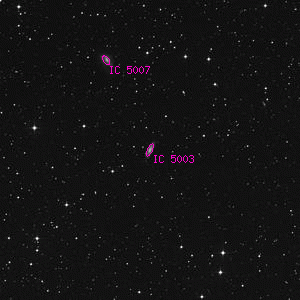IC 5003

Overlaid DSS image of IC 5003, 30' x 30' with north at top and west to the right
Aladin viewer for the region around IC 5003
IC 5029, IC 5039, IC 5046, MCG-05-49-001, ESO 463-20, ESO 463-G020, PGC 65249
| Type | Galaxy |
|---|---|
| Magnitude | 12.6 |
| Size | 1.347' x 0.485' @ 155° |
| Right Ascension | 20h 43' 14.4" (2000) |
| Declination | 29° 51' 12" S |
| Constellation | Microscopium |
| Description | vF, cS, R, 2 st sf in line |
| Classification | Sc |
Observing Notes
Harold Corwin
IC 5003 = IC 5029 = IC 5039 = IC 5046 and IC 5007 = IC 5030 = IC 5041 = IC 5047 are a pair of galaxies found four times by Lewis Swift in the summer of 1897. The first galaxy is positively identified by his descriptions of the nearby star field, while the second is also matched to stars on at least one night and by his relative position from the first (with a 10 arcmin error in the declination in the case of IC 5030) on three others. The RA's are off by various amounts up to 18 minutes of time.
Here are the messy details. On 9 June, Swift found two nebulae (IC 5046 and IC 5047) in the area, and noted three stars nearby. The stars near IC 5046 are described, "eeF * and vF * near sf, point to it." For IC 5047, "8 mag * 31 arcmin n." All three stars are just where Swift puts them, so the identities are secure. Swift's positions are about 1.5 minutes of time too large, and 3.5 arcmin too far south. These two appeared in Swift's 11th list.
Swift again swept the area on 26 July. This time, he noted just the accompanying stars near IC 5030, "F * with dist. com. nr sf, point to it." This, too, is an exact description, but his positions are over 3 minutes of time too small, and his declination for IC 5029 10 arcmin too far south. Swift published these in his 12th list.
Back to his 11th list, Swift has three nebulae found on 29 August. He notes for the first of the three that "2 F sts near nf point to it." His description of the second nebula includes the note, "Near p * of sev curved." He mentions no stars near the third nebula. Herbert Howe has a long note about these three in his paper in MN 60, 29, 1900. Here, he states that he has found only two nebulae in the area, and he speculates that -- because Swift's descriptions of the first two apply equally well to the first of his (Howe's) nebulae -- Swift's first and second objects are probably the same. Howe's description of the field is exact, so perhaps Swift got the date wrong on one object, or he made some other error, perhaps the result of a lapse in memory.
Finally, on 8 September 1897, Swift again recorded two nebulae (IC 5003 and IC 5007). These appear as the 18th and 19th of his 12th list, and Swift has the field described as follows: IC 5003, "2 sts near sf point to it; sp of 2" and IC 5007, "bet 2 groups of B sts sf and np; nf of 2." Again, these are accurate descriptions. Here, his declinations are also accurate being within a minute of the true decs -- but his RA's are 18 minutes of time too small. Were it not for the RA's of IC 4946 and IC 4948 (which Swift found just three nights later on the 11th) also being 18 minutes too small, I would find such large errors hard to believe. I am guessing here, but I suspect that Swift zeroed his telescope on the same wrong star on both nights.
If Howe is correct that Swift recorded the same nebula twice in the same night, then it is also clear that Swift recorded this same object five different times as a "nova," and its companion four different times. I know of no other object with as many independent discoveries by the same observer, and announced as different objects.
ESO, by the way, suggested that the numbers IC 5003 and IC 5007 applied to a star, and also speculated that IC 5004 applied to the same star, though with a 1 degree error in Dec. But Andris Lauberts did not have Swift's lists in front of him when he went over the ESO plates.
In any event, there are only two galaxies in the field, and it is clear that Swift saw them both on at least four occasions that summer.
It's also clear that by this time of his life (he was 77 years old in 1897), his visual memory was failing badly. Also, his 11th and 12th lists of nebulae are thoroughly comingled as far as discovery dates are concerned, so his record keeping skills were also in decline. But he persevered for another year -- he found his last nebulae in the waning months of 1898.
Other Data Sources for IC 5003
Nearby objects for IC 5003
Credits...
Drawings, descriptions, and CCD photos are copyright Andrew Cooper unless otherwise noted, no usage without permission.
A complete list of credits and sources can be found on the about page
IC 5003